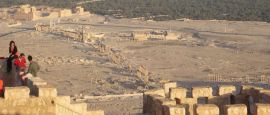As Syria’s civil war continues to rage, the country remains a no-go for tourists. Updates on the attractions below, which once lured millions of tourists to this country, were added to this guide in 2015 and will be reviewed by our foreign correspondents when the war has finished and the dust has settled – whenever that may be.
Syrian Arab Republic things to see and do
Tourist offices
Address: PO Box 6642, Barada Street, Damascus, Syria
Tel: (11) 221 0122.
www.syriatourism.org
A high-profile victim of the civil war, fierce fighting has taken place in the city of Aleppo, much of which has been reduced to rubble. The city contains a massive citadel, which stands on the site of a Hittite acropolis. This UNESCO World Heritage Site is one of the most magnificent examples of Islamic military architecture in Syria, but it’s future is decidedly uncertain.
One of the world's oldest inhabited cities, the Syrian capital has fared much better than other parts of the country during the civil war, but the security situation there is precarious. In more peaceful times, visitors flocked to the city to admire attractions such as Ummayyad Mosque, the 16th-century Tikiyeh Mosque and Al Azem Palace, which houses Islamic art and ancient copies of the Koran. Sadly, it will be a case of seeing what’s left after the civil war.
Famed for its ancient Byzantine ruins, Palmyra has been plundered of its ancient treasures by IS militants and its temples (most famously that of Baalshamin) have fallen victim of the group’s campaign of iconoclasm. Satellite images suggest much of this ancient city has fallen, but the true extent of the damage will not be known until the end of the war.
Crac des Chevaliers is the most famous crusader castle in the world and was a stronghold of the Hospitallers during the days of the Latin Kingdom of Jerusalem (1100-1290). The castle, rising from an altitude of 670m (2,200ft), was protected by watchtowers and supplied with food from the surrounding fertile countryside. The castle fared well during previous military campaigns, but is sadly being destroyed during the current conflict.
Home to some of the oldest minarets in the world, Bosra has become a battlefield in recent years. The first city in Syria to become Muslim, it was used as a stopover on the pilgrimage route to Mecca and prospered until the 17th century. By then the region, as it is today, was becoming unsafe and the pilgrims began to take a less dangerous route further west.
Situated on the River Orontes, 45km (28 miles) from Homs, Hama has fared better than most in the civil war. Dating back to around 5,000BC, Hams is famed for its norias, gigantic wooden waterwheels, which are still used to provide water for the city and to irrigate the many public gardens. The orchards, the Great Mosque and the Al Azem Palace's Museum are also of interest.
Mari's Royal Palace was built by Zimrilim, the ruler of this important city-state some 2,000 years ago, and boasts 300 rooms and hallways. It was rediscovered in the course of excavations during the 1930s, but has been systematically looted by IS militants. Mari itself was built at a strategic point on the trade routes from the Syrian Arab Republic to Mesopotamia. The town's oldest ruins date back 5,000 years, but are currently a no go area.
A stronghold for president Assad, Latakia is located on Syria’s Mediterranean coast. Once a major holiday resort, the town stands at the foot of forested mountains overlooking the beach and the edge of the Fertile Plains (also known as the 'Cradle of Civilisation'). There are a number of antiquities, including the ruined Temple of Bacchus and a triumphal arch.
Before the civil war broke out, visitors came to Syria in their droves and one of the many highlights for sightseers was to explore one of the country’s many souks (markets). Particularly recommended was the one at Aleppo, made up of 16km (10 miles) of meandering low corridors lined with shops and bustling with activity, but that city has been a high-profile casualty of the war. Damascus' Long Souk was also wonderful.
Though the country is in a mess, parts of Syria try to cling on to some semblance of normal life. One facet of local life is to kick back and relax in one of Syria’s well-preserved hammams (public baths).
Sadly the city of Deir ez Zor, once known as the 'Pearl of the Euphrates,' has been the scene of fierce fighting during the civil war. Neighbourhoods have been reduced to rubble and much of the population has been displaced. Located on the bank of the Euphrates, the city was revered for its manicured gardens and orchards, which contrasted beautifully with the golden desert hues and the silver thread of the river.
Do you have any Feedback about this page?
© 2025 Columbus Travel Media Ltd. All rights reserved. No part of this site may be reproduced without our written permission, click here for information on Columbus Content Solutions.








 You know where
You know where